Occupational environment monitoring at a rubber manufacturing factory
99,000 ₫
Note: The above price is calculated for one sample. Prices may vary depending on the area of the environment to be monitored and market fluctuations. For more accurate pricing, please refer to the price list or contact our consulting staff directly.
Monitoring the environment of rubber production factories involves collecting, analyzing, and evaluating workplace factors that may be harmful to workers’ health.
Table of Contents
Toggle1. Overview of Rubber Manufacturing Factories
a. What is a rubber manufacturing factory?
A factory producing rubber is an industrial facility used to process and manufacture products made from rubber. Rubber is a natural or synthetic material obtained from rubber trees. The rubber production process includes multiple stages, from harvesting and processing raw materials to manufacturing and producing various rubber products.

b. Production stages in a rubber manufacturing factory
The production stages in a rubber manufacturing factory may include:
- Rubber harvesting: Rubber trees are cut or tapped to collect rubber raw materials from the bark.
- Rubber processing: After harvesting, the raw rubber is treated to remove impurities and separate it from water. The processing steps may include:
- Bark scraping: The rubber tree bark is removed to obtain the rubber core.
- Rubber core processing: The rubber core is treated to separate the latex and remove other impurities.
- Mixing and processing: Processed rubber is mixed with additives such as reinforcing agents, colors, and flame retardants (if necessary). Then, the rubber is processed into various products such as rubber sheets, conveyor belts, rubber tubes, gaskets, cases, and other products.
- Vulcanization: Vulcanization is the process of creating chemical bonds between rubber molecules, making the rubber stronger and more durable. This process is typically done using sulfur gas or other bonding agents.
- Quality control: Quality inspections are carried out to ensure that rubber products meet standards and requirements. Testing may include hardness, elasticity, durability, water resistance, and other rubber properties.
- Packing and shipping: After production and quality control, rubber products are packaged and prepared for transport to their point of use or distributors.

c. Machinery used in rubber manufacturing factories
In rubber manufacturing factories, various machines and equipment are used for production and rubber processing. Some common machines in the rubber industry include:
- Bark cutting machine: Used to remove the rubber tree bark after harvesting.
- Core peeling machine: Used to remove the outer layer of the rubber core to obtain pure rubber core.
- Grinding machine: Used to grind rubber into smaller particles for further processing.
- Mixer: Used to blend rubber components with additives such as reinforcements and colorants.
- Rolling machine: Rolls rubber into thin sheets or different forms depending on final application.
- Vulcanization machine: Used to carry out vulcanization, creating chemical bonds between rubber molecules to provide elasticity and durability.
- Compression molding machine: Used to form rubber products into specific shapes and sizes, such as wheels, gaskets, rubber tubes, and other items.
- Processing machines: Includes cutting machines, grinders, drills, and lathes, used to process rubber products into their final forms such as accessories, gaskets, tubes, and more.
- Testing machines: Rubber quality testing machines, including hardness testers, durability testers, elasticity measuring devices, and other equipment to ensure products meet quality standards.

d. Occupational diseases that workers in rubber manufacturing factories may encounter
Workers in rubber manufacturing factories may be exposed to several occupational diseases related to production processes and rubber exposure. Some common occupational diseases in the rubber industry include:
- Skin allergies: Workers may develop skin allergies when exposed to allergenic substances during rubber production, such as latex.
- Pneumonia: Prolonged exposure to rubber dust or fumes can cause pneumonia and other respiratory issues.
- Musculoskeletal disorders: Heavy labor in rubber factories can strain bones and joints, leading to arthritis and joint degeneration.
- Nervous system disorders: Exposure to chemical compounds in rubber production may cause nervous system damage, leading to neuropathy, neuromuscular disorders, and related symptoms.
- Digestive system disorders: Contact with chemical compounds in rubber may damage the digestive system, causing conditions like gastritis, colitis, and other digestive problems.
- Muscle system disorders: Physically demanding tasks in rubber factories can strain muscles and bones, causing back pain, spinal degeneration, and other muscular issues.

e. Common types of rubber in the market
Rubber is an important material used in many industries. Some common types of rubber in the market include:
- Natural Rubber: Obtained from rubber trees, known for high elasticity and durability. Commonly used in tires, toys, medical gloves, and various applications.
- Styrene-Butadiene Rubber (SBR): Produced by combining styrene and butadiene, SBR has good elasticity and wear resistance. Used in tires, shoe soles, conveyor belts, and other rubber products.
- Nitrile Rubber (NBR): Resistant to oil, chemicals, and heat. Commonly used in rubber tubes, gaskets, and components requiring chemical and wear resistance.
- Ethylene Propylene Diene Rubber (EPDM): Resistant to weather, ozone, and heat. Used in automotive parts, insulation, water pipes, and harsh environment applications.
- Chloroprene Rubber (CR): Also called neoprene, known for elasticity, oil resistance, and weather resistance. Used in raincoats, protective gear, belts, and industrial applications.
- Silicone Rubber: Heat resistant, oxidation resistant, and electrically insulating. Used in electronics, medical devices, toys, and high-temperature applications.
- Fluorocarbon Rubber (FKM): Also called Viton, highly resistant to oil, chemicals, and heat.
2. Overview of Occupational Environment Monitoring Services
a. What is occupational environment monitoring in rubber manufacturing factories?
Occupational environment monitoring (or workplace environmental measurement) in rubber manufacturing factories involves collecting, assessing, and analyzing measurements of workplace environmental factors in order to take timely actions, minimize environmental hazards to workers’ health, and prevent occupational diseases. Occupational environment monitoring is mandatory for rubber manufacturing factories.
This monitoring plays a crucial role in protecting and promoting workers’ health because workers are the primary resource of a business and directly generate profit. Workers frequently exposed to hazards beyond permissible limits are at risk of health issues and occupational diseases.
REGISTER FOR OCCUPATIONAL ENVIRONMENT MONITORING SERVICE
b. Nam Viet’s occupational environment monitoring program
Nam Viet’s occupational environment monitoring program is developed by monitoring engineers specializing in occupational safety and environmental protection. Aimed at ensuring workers’ health and safety, the program uses modern measurement methods to monitor air, water quality, microclimate, physical factors, dust, and more in the workplace. This program is crucial to maintaining a safe working environment and protecting workers’ health.
Additionally, Nam Viet’s program contributes to researching and developing new solutions to improve workplace environmental quality. With the dedication and professionalism of the monitoring team, Nam Viet’s exclusive program is a breakthrough in occupational safety and environmental management in Vietnam.

c. Standardization in occupational environment measurement processes
Standardization in Nam Viet’s occupational environment measurement process is critical to ensuring accurate and reliable results. To guarantee accuracy, the program follows recognized standards and procedures from the Ho Chi Minh City Department of Health. This ensures that collected data is highly reliable for evaluating workplace environments and making decisions to protect workers’ health.
These standardized procedures also ensure that measurements are performed by qualified monitoring specialists with years of experience, allowing managers and experts to trust results from An Toan Nam Viet and make informed decisions for worker health and environmental protection.
By applying standardized procedures, Nam Viet demonstrates its commitment to safe workplaces and worker health while contributing to the development and improvement of occupational safety and environmental management in Vietnam.
d. Reporting occupational environment monitoring results in rubber manufacturing factories
Monitoring results are prepared according to Form No. 04, Appendix III issued with Decree 44/2016/ND-CP and prepared in two copies: one copy sent to the contracting workplace and one copy kept at the monitoring organization.
The retention period of occupational environment monitoring results is indefinite as required by law.

e. Frequency of occupational environment monitoring according to law
According to Clause 2 of Article 18 of the Labor Safety and Hygiene Law 84/2015/QH13, employers must conduct occupational environment monitoring to assess harmful factors at least once a year.
f. Deadline for submitting occupational environment monitoring reports according to law
The deadline for submission is before December 31 each year. Enterprises at manufacturing facilities must submit occupational environment monitoring results to the local Department of Health where the main office or workplace is located.
When there are changes in technology or production processes, or during renovations/upgrades that may introduce new hazards to workers’ health, enterprises must update occupational hygiene records regarding hazardous factors requiring monitoring.
g. Penalties for violations of occupational environment monitoring by employers
According to Article 27 of Decree No. 12/2022/ND-CP dated January 17, 2022, regulating administrative penalties in labor, social insurance, and Vietnamese workers working abroad under contract:
- Clause 2: A fine of VND 2,000,000 – 5,000,000 for employers who fail to publicly disclose monitoring results to workers at the monitored location and other relevant areas immediately after monitoring results and hazard evaluations are available.
- Clause 3: A fine of VND 20,000,000 – 40,000,000 for employers who fail to conduct occupational environment monitoring to control health hazards according to law.
- Clause 4: A fine of VND 40,000,000 – 60,000,000 for employers who collaborate with monitoring organizations to commit fraud in monitoring activities, but without reaching criminal liability.
3. Harmful Environmental Factors for Workers in Rubber Manufacturing Factories
Workers in rubber manufacturing factories may be exposed to harmful environmental factors that can affect their health. Below are some common harmful factors in the rubber industry:
- Chemical fumes: Rubber factories may use chemicals such as solvents, organic compounds, and accelerators during production. These chemical fumes can cause poisoning and damage the respiratory and nervous systems.
- Rubber dust: The rubber processing may generate rubber dust in the air. Long-term inhalation can cause pneumonia, respiratory problems, and skin allergies.
- Chemicals: Rubber production involves chemicals such as rubber bases, accelerators, reinforcements, and additives. Exposure to these chemicals can cause allergies, skin irritation, eye damage, and potential cancer risks.
- Temperature and humidity: Some rubber production stages involve high temperature and humidity, making it difficult to regulate body temperature. Such uncomfortable environmental conditions can lead to fatigue, stress, and related health issues.
- Noise: Some machinery and equipment in rubber factories can generate high noise levels. Long-term exposure to noise may cause hearing damage and stress.
- Wastewater treatment chemicals: Rubber factories often need to treat wastewater from production. Chemicals used in this process can cause environmental pollution and potential health impacts if not handled properly.
REGISTER FOR OCCUPATIONAL ENVIRONMENT MONITORING SERVICE
4. Measures to Improve the Working Environment in Rubber Manufacturing Factories
To improve the working environment in rubber factories and protect workers’ health, the following measures can be applied:
- Ensure ventilation and exhaust systems: Maintain effective ventilation and strong exhaust fans to remove chemical fumes and rubber dust from the working air. This reduces workers’ exposure to harmful substances and improves indoor air quality.
- Use personal protective equipment (PPE): Provide and ensure correct use of PPE such as masks, gloves, safety goggles, and protective clothing to prevent direct contact with chemicals, dust, and other harmful substances.
- Training and education: Offer training and education on occupational safety and health for all workers. Ensure they understand risks and preventive measures, and know how to properly use PPE and work safely.
- Waste and wastewater management: Implement procedures for handling waste and wastewater from rubber production to comply with environmental standards. Use appropriate treatment methods to reduce pollution and protect water and soil resources.
- Equipment inspection and maintenance: Conduct regular inspections and maintenance of factory equipment to ensure efficient and safe operation. Repair or replace faulty equipment to reduce accident risks and ensure a safe working environment.
- Regularly conduct occupational environment monitoring in the factory, collect and analyze harmful factors, and adjust to reduce hazards to prevent occupational diseases for workers.
5. Benefits of Periodic Rubber Factory Environment Monitoring
An Toan Nam Viet provides businesses with outstanding benefits when using occupational environment monitoring services according to Decree 44/2016/NĐ – CP on the management and control of harmful factors in the workplace affecting workers.
- Businesses can proactively control harmful factors in their workshops or factories.
- Receive advice and recommendations to minimize harmful factors and improve workplace environmental quality.
- Indirectly protect human resources, a key factor in business development.
- Reduce the impact of occupational diseases on health, minimizing future medical costs.
- Improved worker health leads to higher product quality and ensures consistent production output.
- Ensure compliance with labor safety regulations and avoid legal risks.
- Enhance credibility and professionalism, elevating the company’s brand.
An Toan Nam Viet’s environmental monitoring service is a solution to reduce occupational disease risks, contributing to a clean and high-quality working environment.

6. Nationwide Occupational Environment Monitoring Center
An Toan Nam Viet Occupational Environment Monitoring Center is a professional unit for supervising and measuring occupational environment quality across all provinces in Vietnam. With experienced monitoring specialists, the center uses modern measuring equipment to ensure accuracy and reliability.
In addition to monitoring services, the center assists clients in planning, managing, and tracking workplace environmental issues. With the motto “customer-centric,” the center prioritizes client satisfaction and provides optimal solutions for businesses.
REGISTER FOR OCCUPATIONAL ENVIRONMENT MONITORING SERVICE
With investments in technology, equipment, and workforce, An Toan Nam Viet’s monitoring center has become a reputable unit in occupational environment monitoring in Ho Chi Minh City with the following objectives:
- We value our brand reputation and the quality of our services.
- We provide clients with the best and most suitable solutions.
- Alongside experienced Masters and Engineers, aiming to protect the environment and benefit businesses.
- Clients using An Toan Nam Viet monitoring services receive professional support from experts and the best cost advantages.
The occupational environment monitoring process at An Toan Nam Viet includes the following steps:
- Before monitoring, ensure all equipment is calibrated according to legal regulations.
- Follow the committed occupational environment monitoring procedures with the Department of Health.
- Report monitoring results honestly to employers.
- If results indicate unsafe conditions, An Toan Nam Viet will support remediation measures, and the workplace will:
- Implement measures to improve working conditions, minimizing harmful factor exposure and preventing occupational diseases.
- Organize health check-ups to detect occupational diseases early for workers in unsafe positions.
- Provide material compensation to workers according to labor law regulations.

7. Occupational Environment Monitoring Pricing
To help businesses conduct professional and effective occupational environment monitoring, An Toan Nam Viet provides a detailed price list for monitoring services with quality and reasonable costs.
- Our price list provides detailed information on all monitoring services offered, including costs for travel, measurement, analysis, and reporting. Clients can trust the accuracy and reliability of our monitoring reports.
- We commit to offering competitive and reasonable prices, while providing fast and professional consultation for all monitoring service inquiries.
- With An Toan Nam Viet’s monitoring price list, clients can easily select service packages suitable for their needs, ensuring maximum satisfaction with professional service quality.
No comments yet

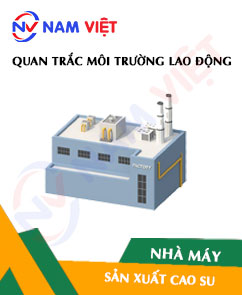
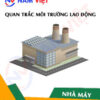
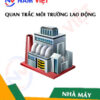
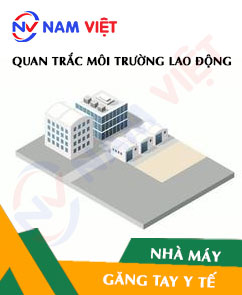


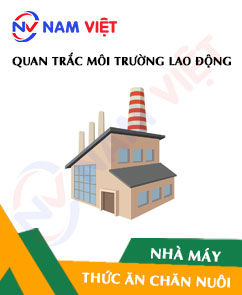
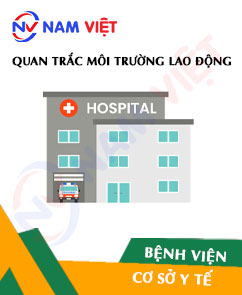
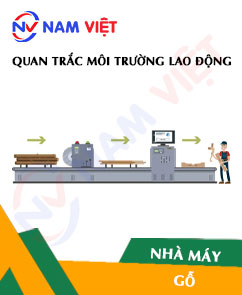
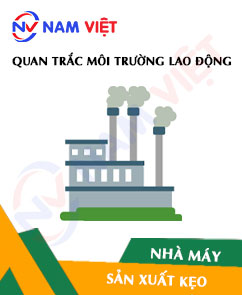
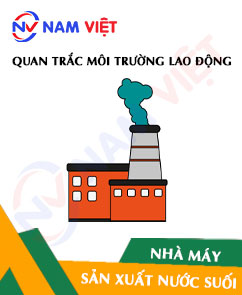
Review Occupational environment monitoring at a rubber manufacturing factory
There are no reviews yet.